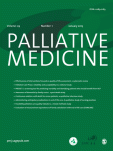Professor Kathy Eagar, Director, Australian Health Services Research Institute, University of Wollongong, Australia, explains the background to her longer article that has been selected as this month’s Editor’s Choice in Palliative Medicine.
More than 20 years ago a group of Australian palliative care clinicians met to identify those patient characteristics that they believed drive both needs and costs in palliative care. That meeting was seminal because, over two decades on, the concept of a Palliative Care Phase is firmly embedded into clinical practice across Australia. Australian palliative care patients have a daily phase assessment and the five Palliative Care Phases − Stable, Unstable, Deteriorating, Terminal and Bereaved − are a common language for the palliative care clinical community. In addition to its use at the bedside, the Palliative Care Phase is the standard Australian unit of counting for payment purposes and for measuring patient outcomes.
The concept of Palliative Care Phase has become firmly embedded into Australian clinical practice since 1997 when Phase was adopted as the unit of counting in the Australian casemix classification for palliative care – the Australian National Subacute and Non-Acute Patient (AN-SNAP) classification. Version 4 of the AN-SNAP classification is in the final stage of development and continues to be built around the concept of a Palliative Care Phase.
The concept of a Palliative Care Phase continues to be built around core principles. The patient and their family are the unit of care, and not just the patient alone. In palliative care, the diagnosis does not predict the need for care nor the cost of that care. Rather, needs and costs are predicted by the stage of illness (the Phase), functional status, pain and symptoms. As patients approach death, they move through one or more Palliative Care Phases and their needs and outcomes can be measured systematically at each phase.
The value of systematically measuring patient outcomes by Phase has been demonstrated by the Australian Palliative Care Outcomes Collaboration (PCOC), a national initiative established in 2005 to drive continuous improvement in palliative care through routine clinical outcome measurement and benchmarking. PCOC has established national benchmarks that all patient outcomes are measured against. PCOC estimates that it now holds outcome data on more than 80% of palliative care patients in Australia. This has allowed the sector to move beyond cross-sectional and short-term studies into large longitudinal studies of national significance.
Implementation of a palliative care data system with Palliative Care Phase as a key level in the information architecture has represented a significant national investment. That investment is paying off as Australia can now routinely demonstrate palliative care patient outcomes and demonstrate value for money.
 Download a free copy of the longer article
Download a free copy of the longer article
This post relates to the longer article, ‘Palliative Care Phase: Inter-rater reliability and acceptability in a national study’ by M Masso, S Allingham, M Banfield, CE Johnson, T Pidgeon, P Yates and K Eagar, published in Palliative Medicine, January 2015 vol.29 (no.1) 22-30. Published online before print 23 September 2014, doi: 10.1177/ 0269216314551814.
EAPC MEMBERS – DOWNLOAD THIS, AND ALL OTHER ‘EDITOR’S CHOICE’ ARTICLES, FREE OF CHARGE
If you are currently an Individual or Associate EAPC Member you have full access to the Members Only Area of the EAPC website, and the chance to download a free PDF of all ‘Editor’s choice’ articles and many other papers too. Just click here, enter your email address and membership password and choose from the list of journal articles.
How to join as an Individual/Associate Member, or to renew your membership
- Individual members are invited to join the EAPC or renew their membership here.
- Associate Members – all current members of our National Associations are invited to join the EAPC or renew their membership for FREE. Click here.
Links

